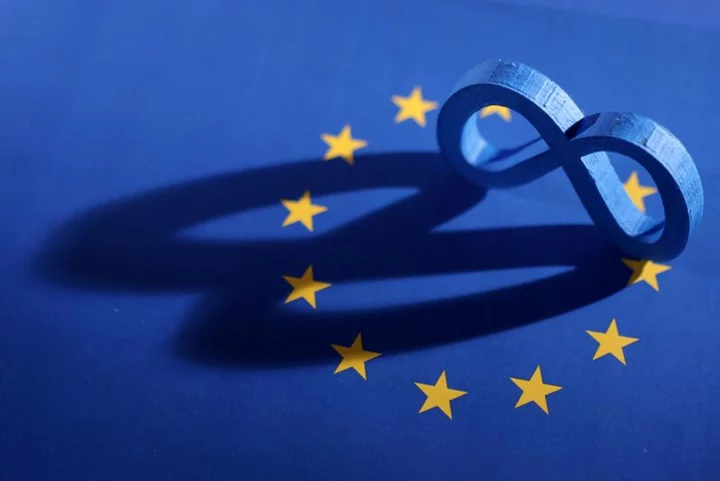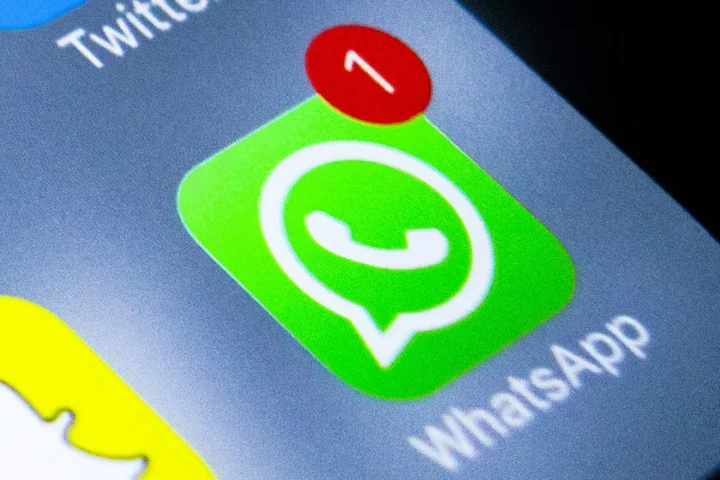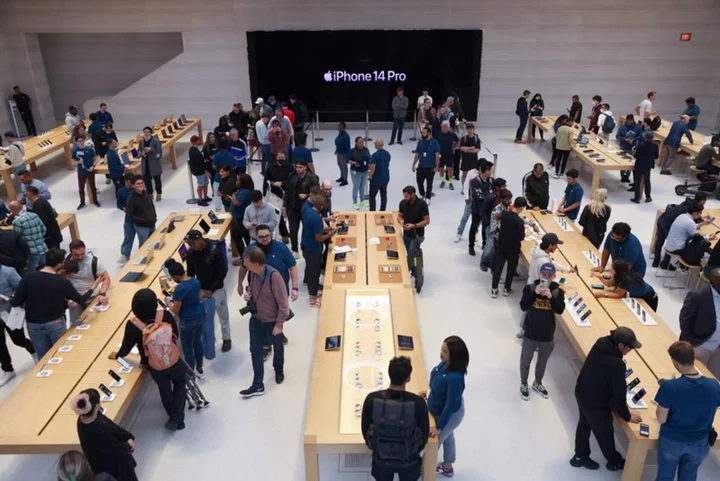
Larry Fink Leads CEOs Back to COP Talks They Snubbed Last Year
Wall Street is returning to climate talks that it largely snubbed last year, as the United Arab Emirates
2023-10-19 19:54

Giant heat-emitting mass discovered under the surface of the Moon
A huge mass of heat-emitting rock has been found buried beneath the surface of the Moon. The incredible discovery was made beneath one of the Moon’s craters, where a large mass of granite has slowly been releasing heat for years. Experts know that the Moon used to have eruptions and lava fields flowing from it, but until now, they have never uncovered evidence that is reminiscent of Earth-like volcanoes, underneath which granite forms when magma cools and crystalises deep beneath the surface. Now, that has changed after astronomers looked a bit more deeply at what lies beneath the Compton and Belkovich craters, located on the far side of the Moon. There they came across a large piece of granite rock that is emitting heat. The discovery excited experts as granite is not commonly found outside of Earth. Granite on the Moon was discovered using data from both Chinese and American lunar orbiters, and the information has revealed a whole new volcanic process never before witnessed. In a statement, one of the lead researchers, Dr Matt Siegler, from the Planetary Science Institute, said: “Using an instrument looking at microwave wavelengths – longer than infrared – sent to the Moon on both the Chinese Chang’E 1 and 2 orbiters, we have been able to map temperatures below the surface. “What we found was that one of these suspected volcanoes, known as Compton-Belkovich, was absolutely glowing at microwave wavelengths.” He continued: “What this means is that it is hot, not necessarily at the surface, as you would see in infrared, but under the surface. “The only way to explain this is from extra heat coming from somewhere below the feature within the deeper lunar crust. So Compton-Belkovich, thought to be a volcano, is also hiding a large heat source below it.” Using the data, they believe the 12-mile wide dip makes up the caldera, or depression, of the ancient volcano, where the surface temperature is 10°C higher than the surrounding areas. The volcano is thought to have last erupted 3.5 billion years ago and experts believe the heat that is emitting from the granite below is due to trapped radioactive material in the rock. Sign up to our free Indy100 weekly newsletter Have your say in our news democracy. Click the upvote icon at the top of the page to help raise this article through the indy100 rankings.
2023-10-19 19:54

BioShock movie writer provides 'optimistic' update on the production
The 'BioShock' movie is being helmed by Francis Lawrence and promises to be a "great, big sprawling nightmare world".
2023-10-19 19:21

Marvel's Spider-Man 2 disc players need to download this update before launch
'Marvel's Spider-Man 2' has some refinements that disc players will get from downloading the launch update.
2023-10-19 19:20

Super Mario Bros. Wonder almost had live commentary
The Nintendo team hired someone who worked on the project for six months, then decided it wasn't right.
2023-10-19 19:19

NY Attorney General sues crypto firms Gemini, Genesis
New York Attorney General Letitia James on Thursday sued cryptocurrency firms Gemini, Genesis Global and Digital Currency Group
2023-10-19 19:19

Meta, TikTok given a week by EU to detail measures against disinformation
By Charlotte Van Campenhout and Bart H. Meijer BRUSSELS (Reuters) -Meta and TikTok have been given a week by the
2023-10-19 18:59

‘Game-changing’ facial recognition technology catches prolific shoplifters
Britain’s biggest police force is using “game-changing” facial recognition technology to catch prolific shoplifters. The Metropolitan Police asked 12 retailers to provide images of 30 of the worst offenders who steal from their shops in a pilot of the new software. They were compared against the force’s custody shots, and of 302 images submitted, 149 came up as positive matches. Those matches are now being investigated further with a view to building criminal cases. The software uses biometric measures of a person’s face and works even if part of their face is covered. It takes around 60 seconds to find a match. Commissioner Sir Mark Rowley said: “We’re working with shops across the capital to target and track down criminals in a way we never have before. “We’re pushing the boundaries and using innovation and technology to rapidly identify criminals. “The results we’ve seen so far are game-changing. The use of facial recognition in this way could revolutionise how we investigate and solve crime.” He claimed that most of the prolific offenders were involved in other, more serious criminal activity. “What’s most powerful is what we’ve learned about those involved in this offending so far. It’s clear the majority are career criminals involved in serious crime,” Sir Mark said. “This data and information helps us focus our efforts in an even more precise way than we originally anticipated. “Through this tactic we’re not only improving how we protect shops and support the business community, we’re stepping further forward in identifying and tracking down serious criminals and protecting all of London’s communities. “The scale of business crime in London is huge. To be successful we have to be precise in our approach and this is a really promising step forward.” Met police last year." data-source=""> Chief executive of the Association of Convenience stores James Lowman said while the technology could save police time, there is still a challenge in getting offenders off the street. He said: “Using artificial intelligence to identify prolific offenders can be an effective way of drastically reducing the amount of police time it takes to make links between crimes committed against different businesses locally. “Whether its artificial intelligence or local intelligence that leads to criminals being identified, the real challenge remains apprehending these offenders and getting them off the streets.” The Met started using the software in August and began the retail pilot in late September. The new system can use images from CCTV, dashcams, doorbell cameras or phones. It uses the same algorithm as the Met’s live facial recognition technology, about which there have been well-publicised concerns over potential bias. Lindsey Chiswick, director of intelligence for the Met and national policing lead on facial recognition, said the algorithm has been independently tested by the National Physical Laboratory. She said: “Facial recognition technology, which is able to match faces after the event, has actually been around for quite a few years. “What’s changed and what is improving all the time, and in the last few years with real speed, is the accuracy of the algorithm. And that’s the real game changer here. “With this technology, it’s an algorithm that we’ve independently tested through the National Physical Laboratory so we have assurance it’s 100% accurate when it comes to retrospective usage, and we understand how it works.” Around 50,000 shoplifting incidents were reported to the Met last year, estimated to be between 5% and 10% of the offences that are actually committed. Emmanuelle Andrews, from human rights charity Liberty that has campaigned against the use of facial recognition, said: “Facial recognition has no place on our streets, in our shops – or in any other areas of our lives. “This technology threatens our privacy and stifles free speech – and we should all be worried about moves to expand its reach. “We’re also concerned about the creep of facial recognition technology into other areas of policing. “Let’s be clear: we cannot rely on tech to solve deep societal problems, this is an unjustified expansion of state surveillance and there are numerous alternatives.” Read More Facial recognition firm Clearview AI overturns UK data privacy fine Sadiq Khan, Met Commissioner to ask phone companies to ‘design out’ theft Microsoft gets go-ahead to buy Call of Duty maker Activision Incels using TikTok to spread ‘hateful beliefs’, research suggests Duke and Duchess of Sussex call for overhaul of social media Google to trial AI in UK traffic light systems to reduce stop-and-go emissions
2023-10-19 17:50

WhatsApp update changes how billions log in to messaging app
WhatsApp is changing the way billions of users log into the messaging app, ditching passwords and two-factor authentication in favour of quicker and more secure passkeys. The move is part of a major shift within the tech industry to move away from decades-old password technology and replace it with the more modern passkey format, which combines biometric information like fingerprints with a simple numeric code in order to identify people. A similar switch was recently announced by Google, which will introduce passkeys to its apps like Maps, Search and YouTube. WhatsApp’s update will only impact Android users to begin with. “Passkeys are a new way to log back into your account,” said Will Cathcart, who heads WhatsApp. “This is a more secure way of confirming it’s really you – and gives you an added layer of security.” WhatsApp is also rolling out self-destructing voice notes to users as part of new measures to improve privacy on the world’s most popular messaging app. The update is currently only available for beta tester users who have the latest version of WhatsApp installed on their phone or computer, though it is expected to eventually be introduced for all users. With more than 2.7 billion users worldwide – the majority of which on Android devices – WhatsApp updates typically need to be introduced gradually in order to make sure any potential security bugs do not have a critical impact. The self-destructing audio messages, first spotted by WhatsApp feature tracker Wabetainfo, is compatible with both Android and iOS users, though no date has been given for when a wider roller out might be expected. WhatsApp does not comment on release schedules for feature updates unless they relate to security. “After sending the voice note with view once mode enabled, you won’t be able to listen to it and the recipient can no longer listen to the voice note after dismissing it,” Wabetainfo noted. “This mode effectively minimises the chances of unauthorised access or later listening, providing a new layer of privacy for sensitive and confidential information.” The latest update follows recently added features like ‘Channels’, which allow people to follow celebrities and companies within the app, and a ‘Create’ button that gives users the ability to make custom art on the platform. The Create feature brings generative artificial intelligence to WhatsApp for the first time, and means users do not require external tools or specific design skills to create the stickers. Instead, the custom stickers can be produced using simple text-based prompts, similar to other AI image generators like Midjourney and OpenAI’s Dall-E. Read More Facebook and Instagram users face monthly fee for ad-free version Meta launches AI chatbots with ‘personalities’ to take on ChatGPT Viral WhatsApp warning of cyberattack targeting Jewish people is fake Amazon trials humanoid robots to see if they can help staff warehouses Tesla’s profits dip as Musk goes on rant about staff working from home
2023-10-19 17:25

EU Proposes Delaying Some ESG Reporting Rules
Europe’s executive arm is proposing a two-year delay in implementing a key element of its sustainable finance framework,
2023-10-19 17:24

Pets pose a serious health threat that we've all been overlooking
While millions of people own cats and dogs and wouldn’t dream of getting rid of them, pets pose a health risk to humans that is massively overlooked, according to a new study. Since the Covid-19 pandemic swept the world with devastating impact, it has become evident how much of a risk new viruses can pose to our well-being. However, experts are warning that it is not just the wildlife trade or exotic animals that we should be concerned about, as pets could also be sources of zoonotic diseases (which jump from animals to humans). Back garden pets, house pets, working animals and even rodents and pests could host new viruses that could affect humans, according to a new study. It warns that the urbanisation of our habitats and climate change will have an impact on diseases and their dynamics. The study was shared in Science Translational Medicine and penned by disease ecologist Amandine Gamble along with a group of colleagues, who gave examples of how companion animals (aka pets) and stray animals carried a risk of zoonotic spillover. While the risk is thought to be small, experts warn it is significantly underappreciated, especially given the frequent proximity human beings have to pets and strays. The study said: “These animals can play critical roles in zoonotic spillover by enabling the maintenance of a zoonotic pathogen, facilitating its spatial spread, acting as a bridge between otherwise unconnected species, or providing particular opportunities for its evolution.” While the zoonotic spillover that caused Covid-19 sparked a global pandemic, any instance of infection that jumps from animal to human is known as a zoonotic, regardless of the numbers affected. Pet parrots are a known transmitter of the Chlamydia psittaci bacterium to humans. Elsewhere, bats and horses are also known sources of zoonotic diseases. In terms of common household pets, cats can act as a link to a number of fatal diseases. The experts explained: “Numbers of infections are low, but plague is endemic in 17 western U.S. states, and many of the small mammals on which cats prey carry Y. pestis. “Consequently, outdoor cats and cats with incomplete veterinary care, combined with human interaction, suggest that cat-transmitted plague can be considered an increasing public health risk.” They conclude that “it is critical to implement surveillance programs allowing us to track changes in pathogen dynamics”. Sign up to our free Indy100 weekly newsletter Have your say in our news democracy. Click the upvote icon at the top of the page to help raise this article through the indy100 rankings.
2023-10-19 17:21

Google bets on India with Pixel smartphone manufacturing
By Tanvi Mehta and Blassy Boben NEW DELHI (Reuters) -Alphabet Inc's Google will start manufacturing smartphones in India and its
2023-10-19 17:20
You Might Like...

Pope Francis warns about AI's dangers

Japan AI Stocks Surge After SoftBank Joins ChatGPT Clone Race

What does Twitter 'rate limit exceeded' mean for users?

Apple heads for largest Q3 revenue drop since 2016 as iPhone sales slow

Christopher Nolan breaks down the best ways to watch a movie, ahead of his ‘Oppenheimer’ release

Thales Announces Support for External Key Management in Oracle Cloud Infrastructure

Biden Names FCC Picks, Pushes for Democratic Majority at Deadlocked Agency

Edgio Expands Leadership Team with Appointment of Chief Revenue Officer to Fuel Next Stage of Growth
